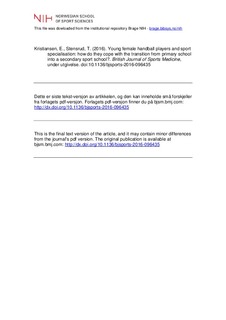| dc.contributor.author | Kristiansen, Elsa | |
| dc.contributor.author | Stensrud, Trine | |
| dc.date.accessioned | 2016-11-01T10:29:34Z | |
| dc.date.available | 2016-11-01T10:29:34Z | |
| dc.date.issued | 2016-09-06 | |
| dc.identifier.citation | British Journal of Sports Medicine. 2016. doi:10.1136/bjsports-2016-096435 | nb_NO |
| dc.identifier.uri | http://hdl.handle.net/11250/2418521 | |
| dc.description | Dette er siste tekst-versjon av artikkelen, og den kan inneholde små forskjeller fra forlagets pdf-versjon. Forlagets pdf-versjon finner du på bjsm.bmj.com /
This is the final text version of the article, and it may contain minor differences from the journal's pdf version. The original publication is available at bjsm.bmj.com | nb_NO |
| dc.description.abstract | Objective:
The aim of the present study was to examine how six young female handball players (aged 13-14 years) perceived the transition from primary school to a sport specialized secondary school.
Methods:
Physical and physiological data as well as data from questionnaires were collected at baseline and after the first year at the sport school, and qualitative interviews were performed retrospectively after the first year at school.
Results:
Evidence of competition related stressors, organizational stressors (sport and school balance), and personal stressors (social life and sport balance, lack of sleep and severe injuries) was found. Three girls developed long lasting musculoskeletal injuries (> 3 months out of ordinary training) and one experienced repeated short periods (≤ 2 weeks out of ordinary training) of injuries during the first year. Onset of menarche and a length growth between 6 and 8 cm during the first year were characteristic traits of the four injured girls.
Conclusion:
From our small study, it appears that young athletes attending a specialized secondary sport school experienced many stressors due to a significant increase in training volume, reduction in sleeping time and development of severe and long lasting injuries. Hence,
trainers at sport schools, club trainers and parents need to communicate and support them in order to prevent this. | nb_NO |
| dc.language.iso | eng | nb_NO |
| dc.publisher | BMJ | nb_NO |
| dc.subject | adolescent | nb_NO |
| dc.subject | exercise physiology | nb_NO |
| dc.subject | injuries | nb_NO |
| dc.subject | physiology | nb_NO |
| dc.subject | psychology | nb_NO |
| dc.title | Young female handball players and sport specialisation: how do they cope with the transition from primary school into a secondary sport school? | nb_NO |
| dc.type | Journal article | nb_NO |
| dc.type | Peer reviewed | nb_NO |
| dc.subject.nsi | VDP::Social science: 200::Social science in sports: 330::Other subjects within physical education: 339 | nb_NO |
| dc.source.journal | British Journal of Sports Medicine | nb_NO |
| dc.identifier.doi | 10.1136/bjsports-2016-096435 | |
| dc.description.localcode | Seksjon for kultur og samfunn / Department of Cultural and Social Studies | nb_NO |
